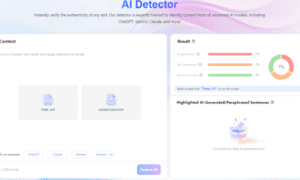The current digital era places a high premium on instant news delivery, leading journalists to engage in superficial reporting. Still, the emergence of advanced news generators has sparked a change that promises substantial improvements within the industry. By relying on cutting-edge AI algorithms, these tools can handle routine coverage duties while liberating human reporters for more profound investigative journalism work – transforming how we view and pursue modern-day journalism altogether.
Ways News Generators Are Helping Journalists Focus on In-Depth Reporting
1. Streamlining Routine Reporting
Automated news generators excel at dealing with predictable, data-based information such as stock reports, sports results, and weather forecasts. Thanks to their structured nature, these stories are ideal for automated reporting. Reporters who use this technology can depend on it to rapidly collate the essential details into a comprehensive article that accurately presents all pertinent facts. This streamlined approach ensures audiences receive timely updates without placing undue demands on human resources.
2. Enhancing Accuracy and Consistency
The significant benefit of news generators lies in their capacity to improve report precision and consistency. These automated mechanisms can process extensive data without the possibility of human mistakes or partiality corrupting things. When journalists employ such tools while generating news articles, they can rely on them for statistical information like stock market fluctuations and election outcomes’ precise reporting accuracy, a crucial factor in maintaining the public trust that counts to sustain the credibility of journalism as an informative source.
3. Freeing Journalists for Investigative Work
The liberating effect of news generators on journalists is their ability to break free from the ceaseless pressure of reporting breaking news, enabling them to engage in a deeper level of investigative work. In-depth journalism plays an essential role by discovering intricate stories that require meticulous analysis and significant time commitment. As routine tasks are automated through these devices, journalists have more space for allocating resources toward covering such pressing issues effectively. For instance, instead of spending hours creating daily financial records, reporters can concentrate on exposing corporate wrongdoings or fraudulent activities related to finances with greater diligence and attention to detail.
4. Facilitating Local News Coverage
Small newsrooms often face restrictions in their coverage of local events due to insufficient resources. Nonetheless, the use of news generators can ease some demands by taking on responsibilities such as providing updates on community happenings and sports scores. By employing this tool to create articles, reporters ensure that they provide thorough and timely information despite having a smaller team size available for managing tasks efficiently. This grants journalists ample time and energy required to cover more intricate civic issues like corruption at local government levels or concerns related primarily to education or public health matters within communities’ confines.
5. Supporting Data Journalism
In today’s data-driven world, the practice of data journalism has gained significant importance. It entails deciphering intricate datasets and displaying them in an easy-to-understand format. With sophisticated tools at their disposal, news creators can process vast amounts of information to generate insightful reports on various topics such as voting patterns, demographic metrics, and polling statistics during election seasons. This allows journalists not only to save time but also to present complex insights clearly and engagingly for all readership groups’ benefit.
6. Reducing Burnout and Improving Work Quality
The demanding nature of their work, including strict deadlines and the ever-present need for fresh content often places journalists under considerable stress. This stressful environment may lead to burnout that in turn can impair the standard of reporting. The automation technology used by news generators serves as a remedy to relieve some pressure on these professionals; allowing them more freedom to channel their focus into producing superior quality reports, attempting innovative narration techniques, and conducting comprehensive research without being perpetually immersed in immediate concerns over breaking news stories. By enabling such shifts, not only do journalists benefit tremendously but also enhances the general level of credibility prevalent within mainstream publications available across all platforms accessible by public viewership at large.
7. Promoting Collaborative Work
Thanks to news generators taking care of the routine tasks of producing news, journalists now have more chances for teamwork. They can collaborate on broader and intricate stories that require varied skills and viewpoints. One potential case is when a group of reporters comes together for an investigative report concerning environmental concerns by pooling their science knowledge, data analysis prowess, and storytelling capabilities. This collaborative approach produces journalism with greater depth and subtlety which then brings bigger effects on public understanding as well as policy-making procedures.
8. Ethical Considerations and Transparency
Despite the numerous advantages offered by news generators, it is crucial to acknowledge ethical implications and maintain transparency. Media outlets must clearly label automated content to ensure accountability for the information produced. This approach fosters trust with viewers or readers who will recognize which articles are machine-generated instead of thoroughly researched and analyzed by human journalists. What’s more? The journalistic quality control team should oversee outputs from these generators to align with professional standards such as editorial policies and ethical codes of conduct.
Create news articles with this tool and provide your readers with in-depth and highly engaging content with fast turnaround times.
Conclusion
Journalism has undergone a significant transformation with the integration of news generators. This shift allows journalists to concentrate on their craft by delegating repetitive tasks, thereby enhancing the caliber and depth of coverage they can provide. With these tools at their disposal, journalists can offer real-time updates that maintain accuracy while channeling effort into investigative journalism as well as local news stories, data analytics, and collaborative projects. This innovative approach not only benefits its practitioners but also enriches public access to pivotal information available today. Technology innovation will continue unlocking the potential for more sophisticated news-generating platforms; thus promising an exciting future where relevant real-time insights about current events merge cohesively with deep informative content shedding light on pertinent issues affecting the global community.



































